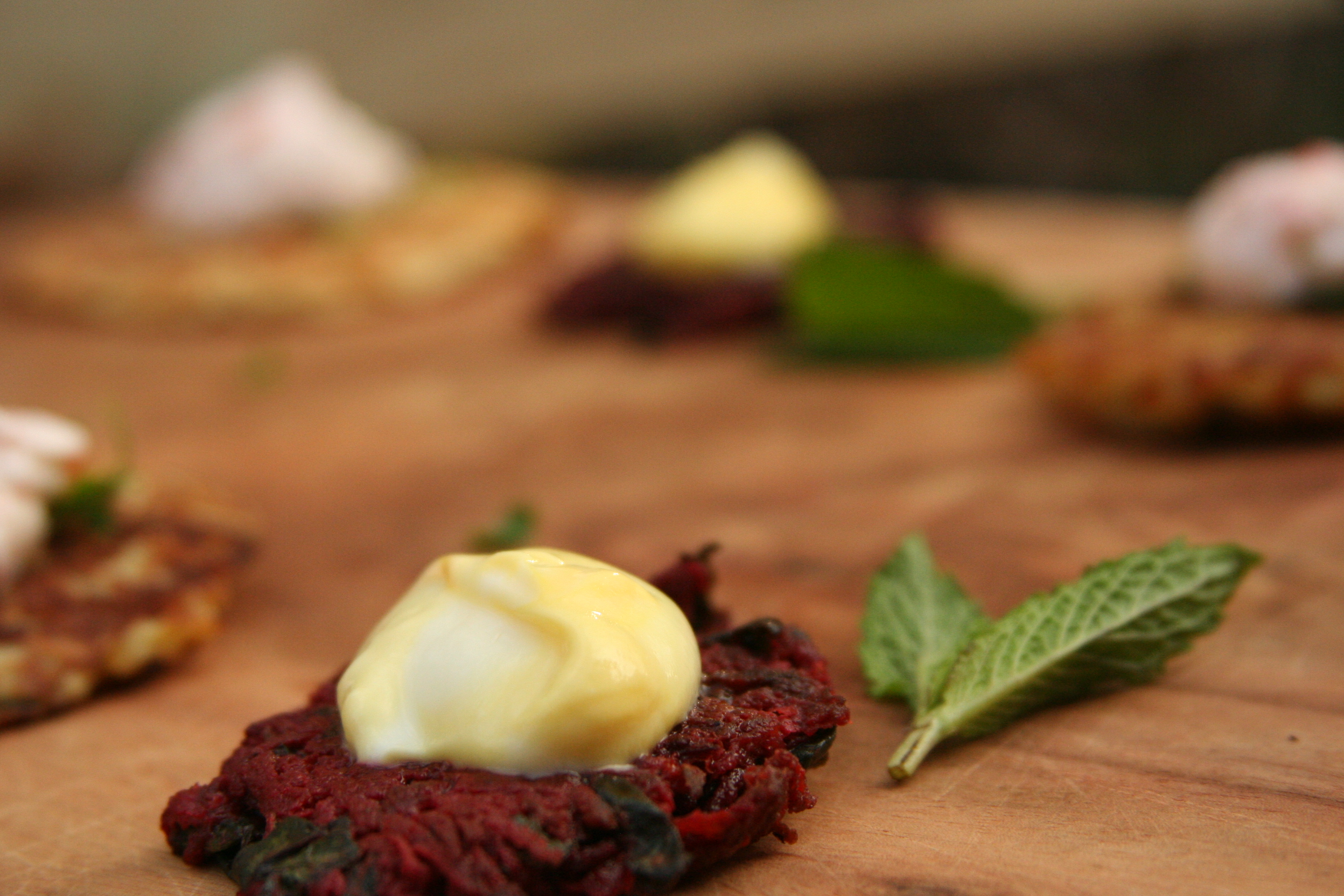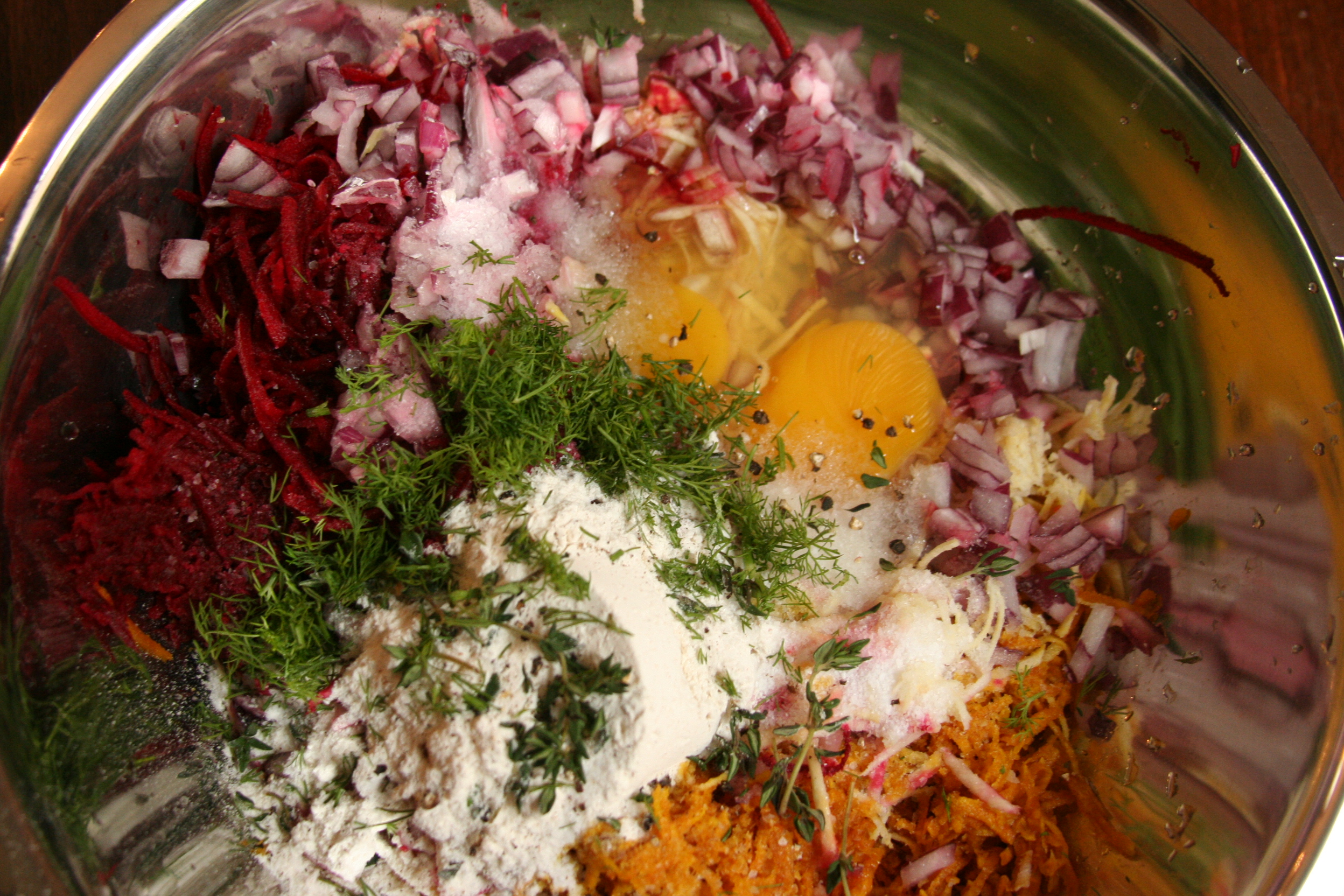Two nights left to cook = Two Way Latkes!!
Beet Latkes with Lemon Saffron Yogurt & Rutabaga Latkes with Horseradish Taramosalata
I’ll be the first to admit that potato latkes are really the best kind of latkes! Especially when they’re made well – crispy, thin and fresh out of the fry pan. Here are a couple of recipes using an assortment of other vegetables you can use to perhaps boost your intake of vitamins and minerals, and to add some variation, colour and seasonal freshness to your plate.
Ingredients:
- 1lb mixed raw root vegetables such as rutabaga, golden beets, red beets and parsnip (other turnips, celeriac and carrots are also fine, although I haven’t tried them) peeled and shredded by hand or using a food processor.
- 1 small or ½ a red onion, minced
- 2-3 eggs
- ¼ c flour (almost any flour, all-purpose, whole wheat, spelt and probably many gluten free flours are also fine)
- 2 teaspoons salt (or just a pinch of salt if using mostly beets, too much salt will stifle their natural sweetness)
- 3 grinds black pepper
- ½ tsp baking powder
- ½ C peanut or grapeseed oil, (approximately) for frying
For the Beet Latkes: 1 bunch lightly cooked beet greens, squeezed and chopped, 2 tablespoons of fresh mint and parsley, zest of ½ lemon,1 tsp ground cumin, 1 tsp tahini.
For the Rutabaga Latkes: 1 tsp caraway seeds toasted over the fry pan before you start your frying, 2 tablespoons dill and/or parsley.
Lemon Saffron Yogurt Sauce for the Beet Latkes courtesy of Yotam Ottolenghi
Ingredients:
- 1 big pinch saffron threads
- 250g Greek yoghurt
- 2 tsp olive oil
- 1 tsp lemon juice
- Salt
First make the sauce. Soak the saffron in two teaspoons of hot water for five minutes. Transfer this to a bowl, add the yogurt, oil, lemon juice, and salt to taste, and stir to combine. The sauce will keep well in the fridge.
Horseradish Taramosalata for the Rutabaga Latkes
Ingredients:
- 1 cup sour cream
- 1 tablespoon freshly grated horseradish
- 2 tablespoon freshly chopped dill
- 3 tablespoons carp roe or salmon caviar (vegetarians, just leave out. The dip is great either way).
- Zest and juice from ½ a lemon (only if using the roe or caviar).
- Salt
- Combine everything and refrigerated until needed.
To make the latkes: Place all your ingredients into a mixing bowl and mix thoroughly. I put disposable gloves on and get down and dirty. I use three eggs; the resulting mixture is lighter, fluffier, and will give you crispier latkes, but it will work fine with fewer eggs, or egg whites if cholesterol levels are a concern. Heat a fry pan with a good amount of oil on a medium flame, and drop spoonfuls of the latke mixture, flattening them with a spatula. When you jiggle the pan and the latke loosens and seems to hold its shape, it’s ready to be flipped. I like to press them thin and cook them quickly on a higher flame.
When deciding what vegetable to use with which sauce, the answer is that it doesn’t really matter. You could use the exact same mixture of root vegetables for either the “beet” or “rutabaga” latkes, and as long as you pair the right herbs and spices with the sauces, they’ll taste great.
A Freilachen Chanukah


